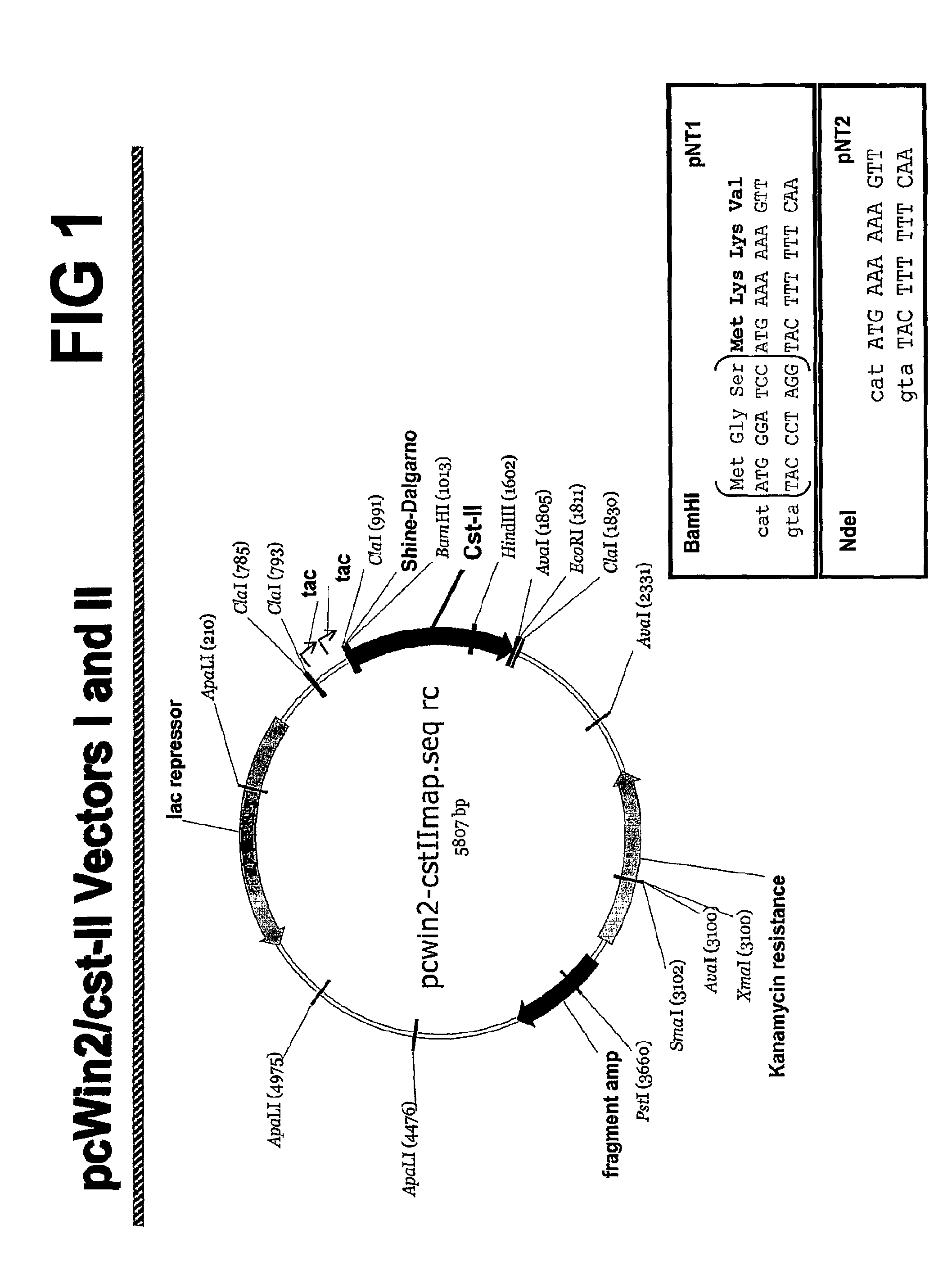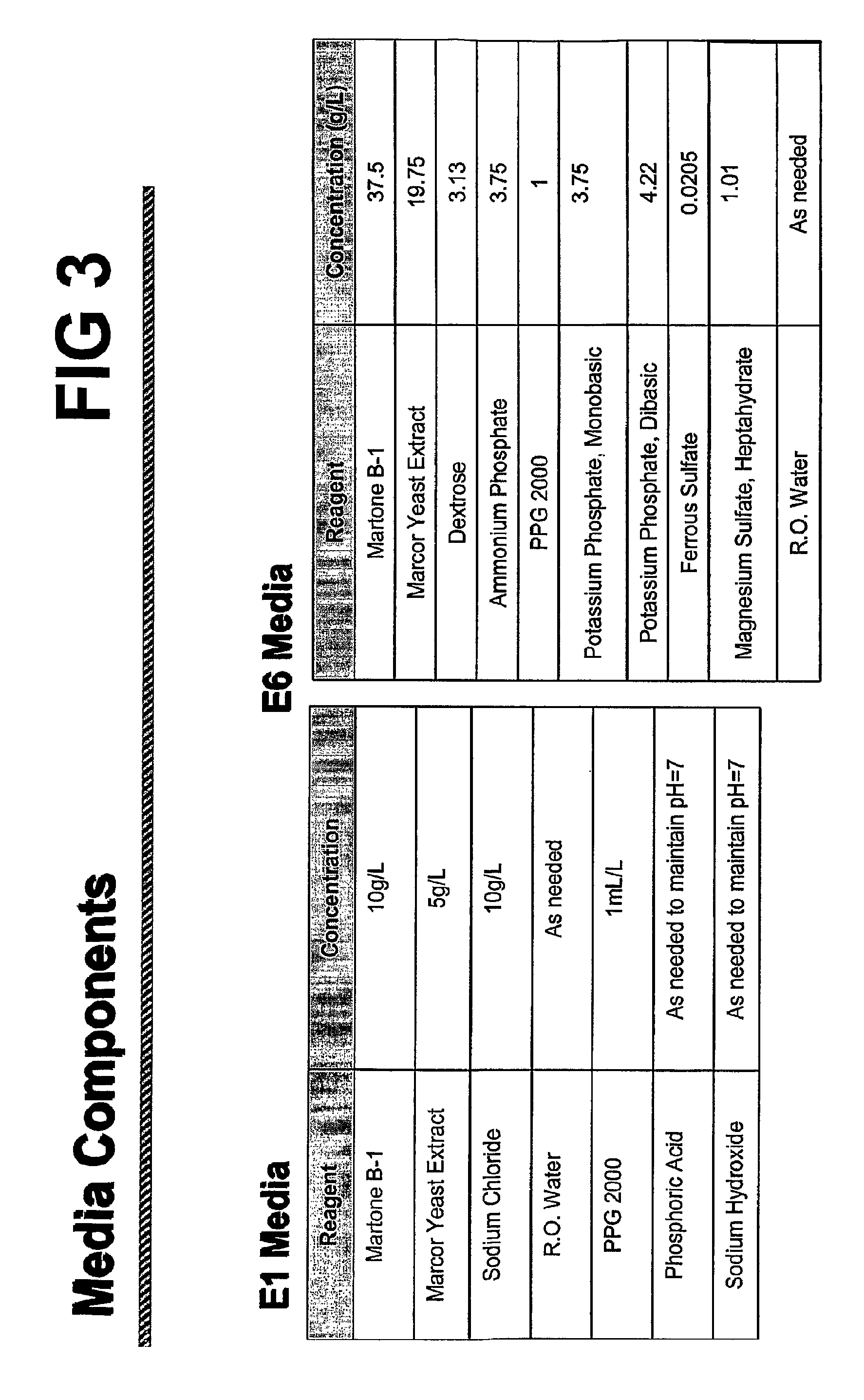Tagged sialyltransferase proteins
a technology of sialyltransferase and protein, which is applied in the direction of growth factors/regulators, enzymes, animal/human proteins, etc., can solve the problems of time-consuming and expensive production by traditional chemical means
- Summary
- Abstract
- Description
- Claims
- Application Information
AI Technical Summary
Benefits of technology
Problems solved by technology
Method used
Image
Examples
example 1
Construction of CSTII Expression Vectors
[0190]The Campylobacter sialyltransferase II (CSTII) nucleic acid was isolated from plasmid pcWori / CSTII. See, e.g., Gilbert, et al., J. Biol. Chem., 275: 3896-3906 (2000). Host E. coli cells were grown on 250 mL of Martone L-Broth with 10 mg / ml ampicillin for approximately 16 hr. Cells were then harvested by centrifugation at 5000 RPM for 15 minutes at 4° C. The plasmid DNA was isolated as described in the manual accompanying the Qiagen HiSpeed Plasmid Maxi Kit.
[0191]Using the PCR technique, a BamHI site was added immediately before the initiating ATG of CstII. Double STOP codons followed by an XhoI site were introduced at the 3′ end of the CstII gene. The protein encoded by this construct encompasses the natural protein sequence for Cst-II with three additional amino acids (MGS) at the amino terminus (SEQ ID NO:2). After subcloning the BamHI-XhoI fragment into the pcWin2 expression vector, competent E. coli cells (TOP10 cells, Invitrogen) we...
example 2
Expression of CSTII Protein
[0194]CSTII protein expression from plasmids pNT1 and pNT2 was tested by growing transformed BNN93 cells on a 10 L scale and isolating protein from the cells. Expression plasmid pNT2 did not express CSTII protein. Expression plasmid pNT1 did express CSTII protein. (Data not shown.) The sequence of the CSTII protein expressed from plasmid pNT1 was analyzed. The expressed CSTII protein begins with MGS MKK (SEQ ID NO:29) and also expresses stably as with either GSMKK (SEQ ID NO:30) and MKK at the N-terminus of the protein as confirmed by N-terminal protein sequencing.
[0195]Fermentation conditions for improved expression of CSTII from pNT1 were determined. Parameters tested included: 1) Fermentation in simple media (designated E1.0) or rich media (designated E6.0); 2) E. coli K-12 host cell line selection using strains JM109 or BNN93 transformed pNT1; and 3) Mode of dissolved oxygen (DO) regulation during fermentation.
[0196]An inoculation culture of E. coli ce...
example 3
Purification of CSTII Protein Expressed from pNT
[0206]E. coli cells that express the pNT1 plasmid were grown as above and then harvested by centrifugation and stored at −80° C. Cell pellets thawed and resuspended in 50 mM Tris, 5 mM EDTA, pH 8.3, (10 mL / g). The cell pellets were homogenized with two passes through a microfluidizer. The lysate was centrifuged at 15,00033 G for twenty minutes and the supernatent was passed through a 0.2 um filter. The lysate was used for the purification methods described below. An exemplary purification protocol is provided in FIG. 4.
Methods
[0207]Protein Concentration Determination (A280). The protein concentration was determined using a spectrophotometer at a fixed absorbance of 280 nm (A280). Prior to the A280 measurement, the spectrophotometer was zeroed (autozero) using the appropriate buffer. The protein concentration was determined using an extinction coefficient of 1 AU=1.012 mg CST-II.
[0208]SDS-PAGEAnalysis. Invitrogen 4-20% Tris Glycine gels...
PUM
 Login to View More
Login to View More Abstract
Description
Claims
Application Information
 Login to View More
Login to View More - R&D
- Intellectual Property
- Life Sciences
- Materials
- Tech Scout
- Unparalleled Data Quality
- Higher Quality Content
- 60% Fewer Hallucinations
Browse by: Latest US Patents, China's latest patents, Technical Efficacy Thesaurus, Application Domain, Technology Topic, Popular Technical Reports.
© 2025 PatSnap. All rights reserved.Legal|Privacy policy|Modern Slavery Act Transparency Statement|Sitemap|About US| Contact US: help@patsnap.com



